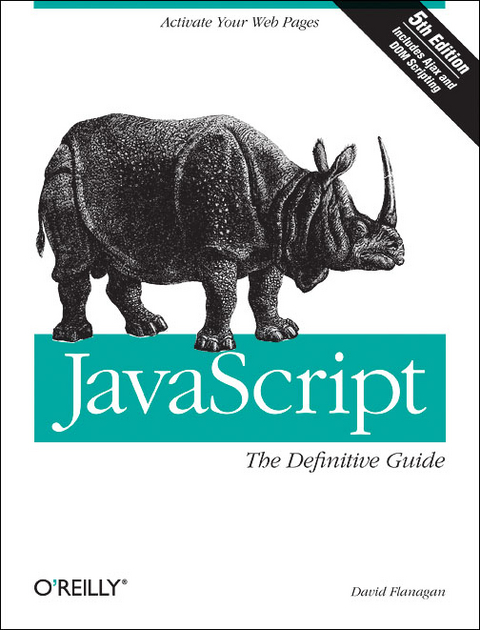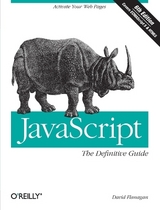
JavaScript the Definitive Guide
O'Reilly Media, Inc, USA (Verlag)
978-0-596-10199-2 (ISBN)
- Titel ist leider vergriffen;
keine Neuauflage - Artikel merken
Part tutorial and part reference, this book not only helps you develop new JavaScript skills by building on your basic understanding of HTML, CSS, and the Web in general, but also serves as a detailed reference for the more experienced web developers among you. Furthermore, the fifth edition now includes advanced material on the latest developer topics, such as scripting Flash with JavaScript, HTTP and Ajax, DOM, SVG, XML, web services, and remote scripting. Like all O'Reilly "Definitive Guides", this book provides the most comprehensive reference section on the market, documenting every object, property, method, event handler, function and constructor used by client-side JavaScript. The new edition has also been revamped to cover the latest browsers, language updates, extensions, and JavaScript standards. No wonder, it's the top-selling JavaScript book of all time. No other book comes close.
David Flanagan is a computer programmer who spends most of his time writing about JavaScript and Java. His books with O'Reilly include Java in a Nutshell, Java Examples in a Nutshell, Java Foundation Classes in a Nutshell, JavaScript: The Definitive Guide, and JavaScript Pocket Reference. David has a degree in computer science and engineering from the Massachusetts Institute of Technology. He lives with his wife and children in the U.S. Pacific Northwest bewteen the cities of Seattle, Washington and Vancouver, British Columbia. David has a blog at www.davidflanagan.com.
Preface
1. Introduction to JavaScript
1.1 What Is JavaScript?
1.2 Versions of JavaScript
1.3 Client-Side JavaScript
1.4 JavaScript in Other Contexts
1.5 Exploring JavaScript
Part I. Core JavaScript
2. Lexical Structure
2.1 Character Set
2.2 Case Sensitivity
2.3 Whitespace and Line Breaks
2.4 Optional Semicolons
2.5 Comments
2.6 Literals
2.7 Identifiers
2.8 Reserved Words
3. Datatypes and Values
3.1 Numbers
3.2 Strings
3.3 Boolean Values
3.4 Functions
3.5 Objects
3.6 Arrays
3.7 null
3.8 undefined
3.9 The Date Object
3.10 Regular Expressions
3.11 Error Objects
3.12 Type Conversion Summary
3.13 Primitive Datatype Wrapper Objects
3.14 Object-to-Primitive Conversion
3.15 By Value Versus by Reference
4. Variables
4.1 Variable Typing
4.2 Variable Declaration
4.3 Variable Scope
4.4 Primitive Types and Reference Types
4.5 Garbage Collection
4.6 Variables as Properties
4.7 Variable Scope Revisited
5. Expressions and Operators
5.1 Expressions
5.2 Operator Overview
5.3 Arithmetic Operators
5.4 Equality Operators
5.5 Relational Operators
5.6 String Operators
5.7 Logical Operators
5.8 Bitwise Operators
5.9 Assignment Operators
5.10 Miscellaneous Operators
6. Statements
6.1 Expression Statements
6.2 Compound Statements
6.3 if
6.4 else if
6.5 switch
6.6 while
6.7 do/while
6.8 for
6.9 for/in
6.10 Labels
6.11 break
6.12 continue
6.13 var
6.14 function
6.15 return
6.16 throw
6.17 try/catch/finally
6.18 with
6.19 The Empty Statement
6.20 Summary of JavaScript Statements
7. Objects and Arrays
7.1 Creating Objects
7.2 Object Properties
7.3 Objects as Associative Arrays
7.4 Universal Object Properties and Methods
7.5 Arrays
7.6 Reading and Writing Array Elements
7.7 Array Methods
7.8 Array-Like Objects
8. Functions
8.1 Defining and Invoking Functions
8.2 Function Arguments
8.3 Functions as Data
8.4 Functions as Methods
8.5 Constructor Functions
8.6 Function Properties and Methods
8.7 Utility Function Examples
8.8 Function Scope and Closures
8.9 The Function( ) Constructor
9. Classes, Constructors, and Prototypes
9.1 Constructors
9.2 Prototypes and Inheritance
9.3 Simulating Classes in JavaScript
9.4 Common Object Methods
9.5 Superclasses and Subclasses
9.6 Extending Without Inheriting
9.7 Determining Object Type
9.8 Example: A defineClass( ) Utility Method
10. Modules and Namespaces
10.1 Creating Modules and Namespaces
10.2 Importing Symbols from Namespaces
10.3 Module Utilities
11. Pattern Matching with Regular Expressions
11.1 Defining Regular Expressions
11.2 String Methods for Pattern Matching
11.3 The RegExp Object
12. Scripting Java
12.1 Embedding JavaScript
12.2 Scripting Java
Part II. Client-Side JavaScript
13. JavaScript in Web Browsers
13.1 The Web Browser Environment
13.2 Embedding Scripts in HTML
13.3 Event Handlers in HTML
13.4 JavaScript in URLs
13.5 Execution of JavaScript Programs
13.6 Client-Side Compatibility
13.7 Accessibility
13.8 JavaScript Security
13.9 Other Web-Related JavaScript Embeddings
14. Scripting Browser Windows
14.1 Timers
14.2 Browser Location and History
14.3 Obtaining Window, Screen, and Browser Information
14.4 Opening and Manipulating Windows
14.5 Simple Dialog Boxes
14.6 Scripting the Status Line
14.7 Error Handling
14.8 Multiple Windows and Frames
14.9 Example: A Navigation Bar in a Frame
15. Scripting Documents
15.1 Dynamic Document Content
15.2 Document Properties
15.3 Legacy DOM: Document Object Collections
15.4 Overview of the W3C DOM
15.5 Traversing a Document
15.6 Finding Elements in a Document
15.7 Modifying a Document
15.8 Adding Content to a Document
15.9 Example: A Dynamically Created Table of Contents
15.10 Querying Selected Text
15.11 The IE 4 DOM
16. Cascading Style Sheets and Dynamic HTML
16.1 Overview of CSS
16.2 CSS for DHTML
16.3 Scripting Inline Styles
16.4 Scripting Computed Styles
16.5 Scripting CSS Classes
16.6 Scripting Stylesheets
17. Events and Event Handling
17.1 Basic Event Handling
17.2 Advanced Event Handling with DOM Level 2
17.3 The Internet Explorer Event Model
17.4 Mouse Events
17.5 Key Events
17.6 The onload Event
17.7 Synthetic Events
18. Forms and Form Elements
18.1 The Form Object
18.2 Defining Form Elements
18.3 Scripting Form Elements
18.4 Form Verification Example
19. Cookies and Client-Side Persistence
19.1 An Overview of Cookies
19.2 Storing Cookies
19.3 Reading Cookies
19.4 Cookie Example
19.5 Cookie Alternatives
19.6 Persistent Data and Security
20. Scripting HTTP
20.1 Using XMLHttpRequest
20.2 XMLHttpRequest Examples and Utilities
20.3 Ajax and Dynamic Scripting
20.4 Scripting HTTP with < script/ >Tags
21. JavaScript and XML
21.1 Obtaining XML Documents
21.2 Manipulating XML with the DOM API
21.3 Transforming XML with XSLT
21.4 Querying XML with XPath
21.5 Serializing XML
21.6 Expanding HTML Templates with XML Data
21.7 XML and Web Services
21.8 E4X: ECMAScript for XML 22. Scripted Client-Side Graphics
22.1 Scripting Images
22.2 Graphics with CSS
22.3 SVG: Scalable Vector Graphics
22.4 VML: Vector Markup Language
22.5 Graphics in a < canvas/ >
22.6 Graphics with Flash
22.7 Graphics with Java
23. Scripting Java Applets and Flash Movies
23.1 Scripting Applets
23.2 Scripting the Java Plug-in
23.3 Scripting with Java
23.4 Scripting Flash
23.5 Scripting Flash 8
Part III. Core JavaScript Reference
Part IV. Client-Side JavaScript Reference
Index
| Erscheint lt. Verlag | 26.9.2006 |
|---|---|
| Zusatzinfo | Illustrations |
| Verlagsort | Sebastopol |
| Sprache | englisch |
| Maße | 186 x 234 mm |
| Gewicht | 1266 g |
| Themenwelt | Mathematik / Informatik ► Informatik ► Programmiersprachen / -werkzeuge |
| Mathematik / Informatik ► Informatik ► Web / Internet | |
| ISBN-10 | 0-596-10199-6 / 0596101996 |
| ISBN-13 | 978-0-596-10199-2 / 9780596101992 |
| Zustand | Neuware |
| Haben Sie eine Frage zum Produkt? |
aus dem Bereich



